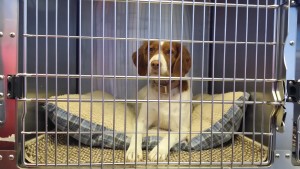
Dogs like to feel safe and they feel safest when they know where they belong. They are not at their best without clear, well-defined rules and clear cut boundaries. This is the why factor for the value of crate training your dog. So, to crate train your dog, and to use the crate throughout the dog’s lifetime, you are providing the dog with a safe place to rest and a safe place to be in your home… as well as your car.
Dogs appreciate consistency. A crate speaks well to being consistent. You keep it in the same place, you keep the same bedding in it and you always ask the dog to be in it to sleep or to ride in the car. Your dog will learn to trust that you are providing a safe place for them to be and this will reduce the dog’s overall stress.
When your dog is a puppy, it is a good idea to crate train to help facilitate potty training more quickly and easily. Much like a baby or small child who gets put to bed for naps and at bedtime, you put the dog in a crate to sleep at night or for naps during the day. When you put the dog into the crate, say “Good boy/girl”, give the dog a small treat, close the door and walk away. At first the dog will whine and carry on but as long as they have eaten, exercised and gone potty, their needs are met and it is time to take a nap. The whining and crying will stop shortly. Shortly may be a relative term when you are hearing the whining, but be patient and don’t give in, the life-long benefits are worth it by keeping them in the crate. Leave the puppy to sleep for a nap or through the night. Your first exercise upon coming out of the crate is to go outside for potty.
In the car, you want to follow the same procedure. It is recommended to keep a crate in your car for the dog, complete with the bedding, so the crate is always ready to go. The crate should be in the back if you drive an SUV, or safely in the back seat of your car, never in the front seat for the same reason you don’t put children there. This will help the dog to avoid motion sickness caused by being able to see out the windows and watching things going flying by. Like us in the car, the dog should be safely restrained.
The car is not another play place. It should be taken seriously and the dog should be in the crate and away from you as you drive. Even if the dog is whining etc. while in the crate, ignore this behavior. It will only take a short time for the dog to figure out that being in the car means going in the crate and being quiet.
If your dog is older and not crate trained for your home or car, it is recommended at the very least training him/her to travel safely in a crate in the car. Having your dog safely contained in a crate will allow everyone to safely enter and exit the vehicle without incident with the dog. It also helps to reinforce rules and boundaries for the dog which are consistent and very believable. This will also help to minimize damage to your car as the dog will be safe in its crate when you stop and have to exit the car for brief periods, and of course, never leave your dog in the car without proper ventilation. Always remember… when taking longer trips with your dog, it is important to get the dog out to walk periodically. The dog needs to relieve itself , too, and should be given the opportunity to drink water.
A dog with clear set boundaries and rules will be a happy dog, making your life with him or her rewarding for everyone. Crate training should be a key part of this.
About the author- Julie Nelson is the owner of Paws In Time dog daycare and boarding centers in Oswego and West Chicago/Batavia. Julie’s entire life has been dedicated to the care of dogs through training and offering state-of-the-art services to over 2,000 clients.

